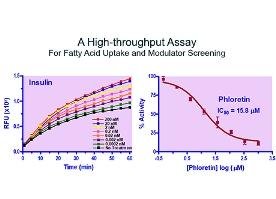QuantiChrom™ Fatty Acid Uptake Assay Kit
Application
- For quantitative determination of long-chain fatty acid uptake in whole cells and evaluation of effects of ligands or drugs on fatty acid transport.
Key Features
- Safe. Non-radioactive assay.
- Fast and Sensitive. Homogenous “add-and-read” assay. No wash, lysis, or staining steps are needed.
- Simple and Convenient. Can be automated as a high-throughput assay for fatty acid transport and modulator screens in cells.
Method
- FL 488/523nm
Samples
- Adipocytes and other fatty acid-transporting cells. Or compounds that affect fatty acid uptake activity
Species
- All
Procedure
- 2 hrs
Size
- 100 Tests
Shelf Life
- 12 months
More Details
LONG CHAIN FATTY ACIDS (LCFA) are important fuel sources for animals as substrates in β-oxidation and serve as building blocks for many different cellular structures. Long-chain unesterified fatty acids (LCFA) are transported into cells using membrane transport proteins, and increased LCFA levels in cells are common in diabetes, obesity-related diseases, cardiovascular disease, and certain forms of cancer. Therefore, fatty acid uptake is a significant therapeutic target for the treatment of metabolic disorders and an important topic for metabolic research.BioAssay Systems’ fluorescent cell-based fatty acid uptake assay uses a fluorescent fatty acid analog which is taken up by fatty acid transporter proteins and accumulates within the cell. Quench reagent is added to block extracellular fluorescent signals in the medium. The adherent cells import the fatty acid analog, and the bottom-read fluorimeter measures the increase in fluorescence signal at λex/em = 488/523nm. This high-throughput assay can be applied to assess fatty acid uptake activity in cells and to screen for activators and inhibitors.What cells are compatible with this kit?
This kit was developed with 3T3-L1 differentiated cells, and has not been tested with other cell lines. However, cell lines that are adherent and capable of fatty acid uptake can also be used with this kit. Suspension cells lines are not compatible with the kit. Please keep in mind that the recommended plating amount (5-8 x 104 cells/mL) will vary depending on the cell line.
I have read some papers where instead of plating differentiated 3T3-L1 cells the night before, the authors instead differentiate the cells in the well plates over two weeks. Can I use this method instead?
We have not tested this method, although it theoretically should work. You will have to normalize the amount of cells per well, however, since one well may have less differentiation than another and thus would have lower uptake which would be falsely attributed to the test compound.
I would like to run this assay in a 384-well plate instead of a 96-well plate to conserve cells. Can this assay be used in a 384 well plate?
We have not tested the assay in a 384 well plate, but it is likely that this is compatible. The recommended cell amounts should be divided by 4, so instead of 50,000-80,000 3T3-L1 cells per well you should use 12,500-20,000 cells per well. The reagents should be divided by 4 as well, so 0.25 µL of Substrate, 2 µL of Quench Reagent, and 25.25 µL of Assay Buffer, and add 25 uL of Working Reagent to the sample.
Can I use a 96 well plate which is not clear-bottom for this assay?
No. The assay functions by reading the increase in fluorescence from the imported substrate, but this is only visible from the bottom of the plate (where the cells are attached.)
I don?t have excitation filters of 485/515 nm. What can I set my fluorimeter to instead?
The Excitation filter may be anywhere from 470 to 500 nm, and the Emission filter may be set anywhere from 500 to 560 nm. Please keep in mind that setting the filters outside 485/515 nm will result in lower fluorescence intensity.
I want to run my samples over several days. Is it all right if my reagents undergo several freeze thaw cycles?
The assay buffer will be fine. The Quench Reagent and Substrate are more sensitive, so it is recommended to aliquot them into several microcentrifuge tubes to prevent multiple freeze-thaw cycles, and covering the tubes in aluminum foil.
I am running differentiated 3T3-L1 adipocytes with insulin and am receiving different results than those shown on the protocol sheet. Why don?t my results match?
Since 3T3-L1 adipocytes need to be differentiated in order to express the fatty acid uptake proteins, you may have different levels of differentiation than the cells used for our protocol sheet graph. The graph is only meant as an example of how the kit works and how the kit can be used to track changes in fatty acid uptake.
No citations for this new product. Please check back later. You may click here to check if citations are available, but are not listed here yet.
If you or your labs do not have the equipment or scientists necessary to run this assay, BioAssay Systems can perform the service for you.
– Fast turnaround
– Quality data
– Low cost
Please email or call 1-510-782-9988 x 2 to discuss your projects.

$489.00
For bulk quote or custom reagents, please email or call 1-510-782-9988 x 1.
Orders are shipped the same day if placed by 2pm PST
Shipping: RT
Carrier: Fedex
Delivery: 1-2 days (US), 3-6 days (Intl)
Storage: -20°C upon receipt
Related Products
You may also like…
| Name | SKU | Price | Buy |
|---|---|---|---|
| QuantiFluo™ Cholesterol Uptake Assay Kit | DCUT-100 | $349.00 |
Why BioAssay Systems
Quality and User-friendly • Expert Technical Support • Competitive Prices • Expansive Catalogue • Trusted Globally
